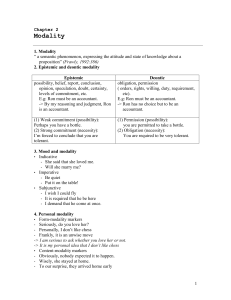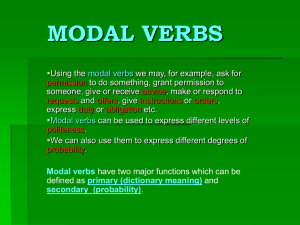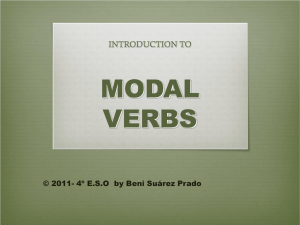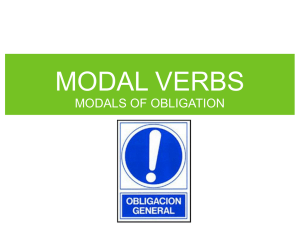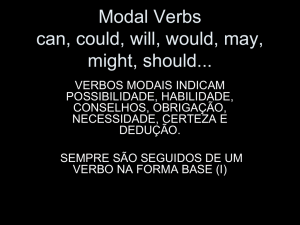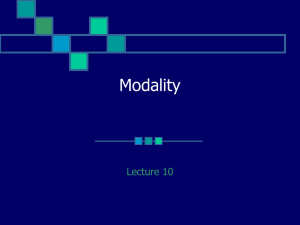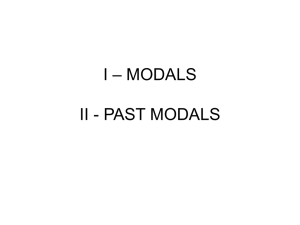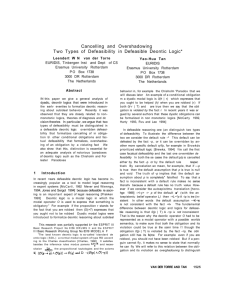Corpus evidence for the acquisition of modal verbs of obligation by
advertisement
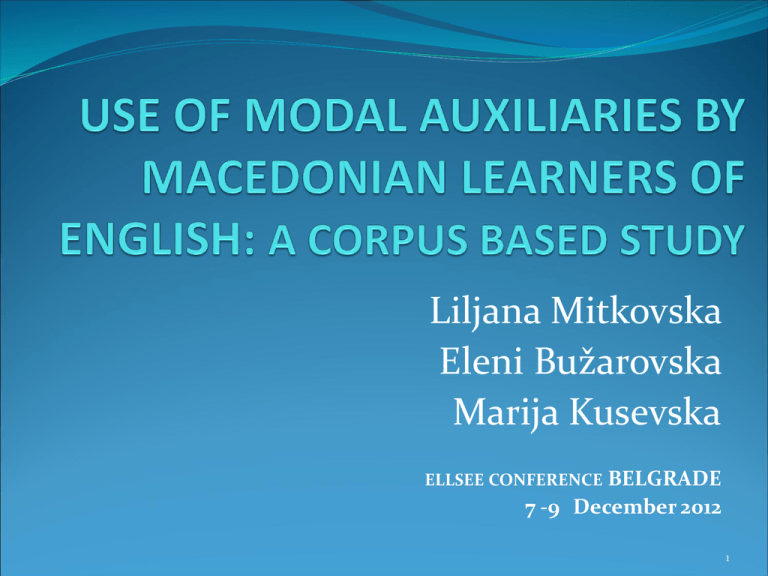
Liljana Mitkovska Eleni Bužarovska Marija Kusevska BELGRADE 7 -9 December 2012 ELLSEE CONFERENCE 1 Aim of presentation to investigate the use of English modal verbs of obligation and possibility by Macedonian learners of English at level A1, A2, B1 and B2 regarding their frequency of occurrence and their functional distribution; to provide some accounts for the most common errors in function and form; and to point out areas for further research. 2 Outline of presentation Methodology of research Modality in general and comparison of the basic features of English and Macedonian modal verbs on which our hypotheses are built Distribution of modal verbs in the corpus, comparing frequency at all levels with the frequency attested in native English corpora Analysis of the basic uses of modal verbs of obligation and possibility with comments on most common errors in function at each level Conclusions and suggestions 3 Methodology Analyzed data comes from the Macedonian English Learner Corpus (MELC) electronic data base of written material collected from learners of English in Macedonia at various ages and proficiency levels Contains around 500 000 words written by around 2000 participants 4 MELC data base Sub-corpora according to several parameters: Age: (5-15) children; (16-60) adults; Level: A1, A2, B1, B2 (C was not considered) Mother tongue: Macedonian - Manual analysis of texts - AntConc (free concordance program) 5 Methods of analysis Corpus-based contrastive interlanguage analysis advocated by Granger et al. (2002) The Centre for English Corpus Linguistics (CECL, Leuven) Involves studies of the learner IL as a system in itself compared with other systems: - with the TL and the NL; - with other ILs Aim: to reveal levels of overuse and underuse of certain structures or lexical items and provide evidence for possible NL influence We compare IL with TL and NL 6 Modal verbs Modality: speaker’s attitude or opinion towards the situation or state of affairs described 2 basic types of modality Deontic modality: meanings of obligation, permission and ability The children must be in bed by nine o’clock. Epistemic modality: the deductions or conclusions made by the speakers It’s past nine, the children must be in bed now 7 Modal verbs (2) Deontic and epistemic modality is expressed with the same modal verbs both in Eng and Mac. In child language acquisition deontic meanings develop before epistemic ones SLA research has shown that “the use of modal auxiliaries in epistemically modalized utterances is a late achievement” (Stephany 1995: 112) 8 Modal verbs in the corpus We examined the following English modals in their deontic and epistemic uses: Modals of obligation - must, have to, need to, should Modals of possibility- can, could, may, might Table 1: Distribution of the modal verbs of obligation in the corpus MELC MUST HAVE TO SHOULD NEED TO Native corpora A1 A2 B1 B2 6 0.041% 95 0.100% 172 0.107% 157 0.088% 5 0.034% 79 0.083% 208 0.130% 183 0.102% 1 0.006% 61 0.064% 153 0.095% 221 0.124% 2 0.013% 32 0.033% 63 0.039% 68 0.038% COCA BNC All: 0.036% 0.057% Spok: 0.020% 0.042% All: 0.049% 0.040% Spok: 0.095 0.089% All: 0.054% 0.078% Spok: 0.062% 0.070% All: 0.023% 0.020% Spok: 0.030% 0.029% 10 Table 1. Occurrences of modal verbs at each level Percentage is calculated from the number of words in each sub-corpus. Results from the children’s corpus (age 5-15) and the adults’ corpus (age 16-60) are not given separately. Compared to the frequencies of the same modals in: - COCA: Corpus of Contemporary Am. English, 400 mill words (1990- 2010) - BNC: British National Corpus, 100 million words (1970-1993). We present overall frequencies as well as results for spoken register; comparison with data from spoken sub-corpora is more indicative because: - Modals are more common in spoken register (vs. journalistic/academic) - most uses of modals are related to discourse functions - the written material is mostly communicative 11 Statistical data At A1: rather limited occurrence of modals of obligation. (small corpus?) At A2: all four modals are much more present. Must: considerably overused (even in relation to the more conservative Br.Eng), have to: slightly underused relative to spoken registers (commonly used by native speakers) should and need to seem to be used appropriately by the learners need to has not been fully acquired (details later). At B1: overuse of must continues; use of have to increases as well (evident with adults). slight overuse of should, need to seems to be close to native frequency of use (coll) At B2: use of must and have to drop; use of should increases (probably because of to the types of the texts written by upper intermediate students) 12 Semantic components in modals of obligation must: external obligation (speaker), internal obligation, categoricality, subjectivity have to: external obligation (circumstantial obligation) need to: external obligation, internal obligation (obligation imposed by smth. internal in the doer) should: internal obligation (correct or sensible action) neutral (advice or suggestion) mora: external obligation (circumstantial and speaker) treba: internal obligation Intensity scale: mora is more categorical than treba. L1 equivalents of English modal verbs of obligation Learners establish equivalents on the basis of their perception of closeness of functions and will rely on the distinctions that are familiar to them from their NL. obligation from the speaker vs. circumstantial obligation is irrelevant for Macedonian speakers. Result: distinction between must and have to will not be fully understood The force of obligation (more or less categorical) is the most important difference between mora and treba. Must is stronger, so they equate it with mora. Result: overuse of must (will be used for strong obligation and necessity more often than by native speakers) 14 Should & need The modal should corresponds more closely to the meanings of treba which, being weaker, implies that something is appropriate or socially acceptable Result: learners will acquire the central uses for moral obligation, advice and suggestion easily. The uses of need also correspond to treba where it points out the internal needs of the subject Result: -> confusion of need with have to 15 Analysis of usage contexts Epistemic vs. deontic meanings Epistemic must (limited) - at level B1 (6, one of them for past deduction) (1) I write to come in your country. It must be fantastic. - at B2 (13, five of which were for past deduction). (2) I was playing basketball and I must have lost the money on the playground. (B2) the modals mora and especially treba are not commonly used in epistemic sense. The adverbs najverojatno, sigurno etc. are more usual markers 16 The use of MUST At A2: more often for circumstantial obligation (+subjective attitude) (3) I must vizit to your country in november end I ask for some advise. Subjective attitude: when moral/social necessity is implied; strong advice. (4) We must all respect our teachers and future teachers. At B1: in obligation and necessity the subjective attitude it not clear (5) That means that I must study all day on Saturday. Expressing strong subjective attitude and advise is also present. To introduce a topic in the discourse (native speakers -have to) (6) I must tell you that I made body piercing… At B2: all uses continue; some contexts have to or even should better (7) Oh, I must take you out this weekend. 17 The use of HAVE TO At A2: for circumstantial necessity (especially adults) for advice (8) During the week I have to get up early. (9) What is the best time to visit Croatia, what place I have to visit and what is the best wey to get there. (A) At B1: for circumstantial obligation, (with moral overtones) -adults use it a lot for discourse function. (10) And also, we have to worry about our health … (Ch) advice function instead of should (11). (11) What you think, which place I have to visit? (A) At B2: the same uses; some inappropriate neg. forms (shouldn’t) (12) Some smokers … think that they don't have to be treated as children and they should do whatever they want (A) 18 The use of SHOULD A2: moral obligation (appropriate action). Adults have used it predominantly for advice and suggestion. (13) I vizit to Venice for two weeks. Do you think I should hire a car or travel by bus? The use of should increases at level B1 and especially at B2 (correctly used) - for moral/social obligation; duty; correct or sensible action, - extensively used for speech acts: suggestions, advice, arrangements. (14) In Sunday I think we should go to the Museum. (15) When and where should we meet? 19 The use of NEED TO At A2: confuse need to and have to/should (= treba). (16) but the director is very proud because the movie needs to be komedi. (Ch) (17) Every building need to have video surveillance esecialy schools. (A) At B1 and B2 learners still don’t have a stable use of need to: sometimes used in contexts where should or have to is more appropriate. (18) Can you please tell me some good places witch I need to visit? (B1) (19) You need to show me around. (B2) 20 Distribution of the modal verbs of possibility in the corpus Table 2: MELC A1 CAN COULD MAY MIGHT A2 B1 Native corpora B2 86 0.59% 518 0.55% 1067 0.66% 1265 0.71% 2 0.002% 45 0.05% 198 0.12% 218 0.12% 4 0.004 22 0.001% 44 0.02% 6 0.006 15 0.009% 22 0.01% 0 0 COCA BNC All: 0.152% 0.160% Spok: 0.17% 0.216% All: 0.097% 0.102% Spok: 0.09% 0.106% All: 0.060% 0.090% Spok: 0.005% 0.031% All: 0.041% 0.047% Spok: 0.038% 0.061% 21 Semantic components in modals of possibility Can: ability, circumstantial ability, permission, circumstantial possibility (speech acts of suggestion, requests, offers, etc). Epistemic meanings rare (Thompson & Martinet) Could: ability/permission in the past, polite request Epistemic possibility May: permission; Epistemic possibility Might: Epistemic possibility (probability) Mozhe: all the above deontic and epistemic meanings (adverb mozhebi more common, bi-forms -for politeness) Hypothesis for interference Learners establish equivalents Mozhe is can This leads to overuse of can and underuse of may Bi-forms are equated with could & might Expectation: more frequent use by adults than by children CAN – mostly deontic Can: the most frequent modal. Deontic functions: ability, circumstantial ability, suggestion and request At A1&A2: dominantly for requests (with adults) (20) Can I ask you something? (A) At B1: circumstantial ability and requests (21) So, you can visit me when you want (A) At B2: requests dominate (children), circum. ability (adults) Sometimes negated can used instead of may or should. (22) The parents can not go to school. (Ch) MAY – mostly epistemic May: rarely used. It appears marginally at A2 (adults) with more examples of epistemic possibility than deontic permission At B1: more examples of epistemic possibility than deontic (23) My school after 100 years may seem like a huge building (Ch) (24) Well i may go with a car, but I'm not sure yet. (A) Often confused with deontic can in offers, requests and suggestions (B1). (25) May I help you? (Ch) (26) May you go with me and show all that places? (A) At B2: epistemic use sharply rises over the deontic (27) it's about some legal documents and it may take hours to be done. Adults: past possibility occurs (They may have been the best moments) COULD – deontic and epistemic Could: rather infrequent at A2 level where it first appears Often used deontically for suggestion as an equivalent of the Mac. bi. (28) You could plant trees, you could help endangered animals (Ch) almost no requests in children’s use -> unawareness of politeness strategies with adults could is mostly used for polite requests (at all levels) the past ability form occurs (29) I could always understand what she was trying to get (A) B1: politeness used by children Epistemic meaning of could appears with adults first (30) But, you know, parking could be difficult. (A) B2: could still interpreted as potential bi mozhel (sometimes with maybe) (31) I’ll give you a call, maybe we could hang out. (B2) MIGHT- only epistemic First appears at A2 with adults to express probability. At B1: probability, sometimes supported by an adverb maybe (double marking) (32) Or maybe, she might be ill. (A) At B2 adults differentiate between epist. could and might. (33) First, we could have a dinner and then we might go to cinema. (A) Conclusions - possibility modals Frequency: can (2050 tokens) vs. might (30) & may (61) Order of acquisition: can- A1, could -A2, may & might-A2 (adults only) -> could, may, might are used at B1 level. At A1&A2: deontic can is overused at the expense of may At B1 can is still confused with may. could (deontic) not used by children at lower levels epistemic could appears at B1 (potential mood marker) Conclusion - Implications for teachers Avoid oversimplification: constant reference to L1 modal verbs in teaching process: must (mora), should (treba), can (mozhe) Offer help: presentation of different situations and discussion on appropriateness of use e.g have to than must (culture-based) Make students aware of the different attitudes and norms that these verbs express (must decreases, need to & should increases) Explain the overuse of can: implement the use of may in both deontic and epistemic meanings at A levels and explain the politeness function of could and may 29


